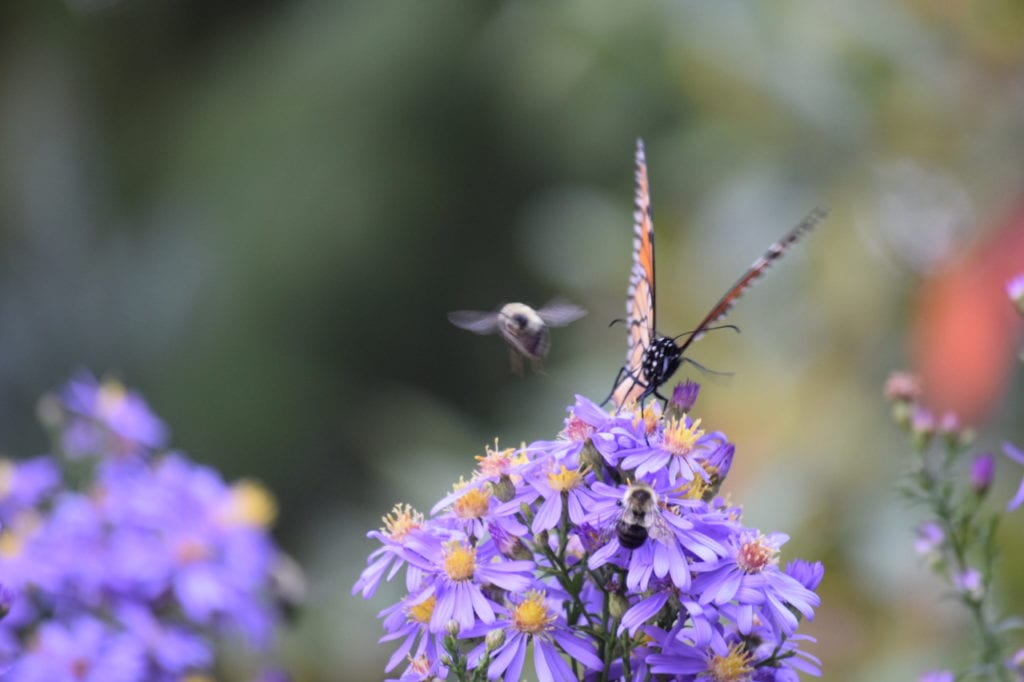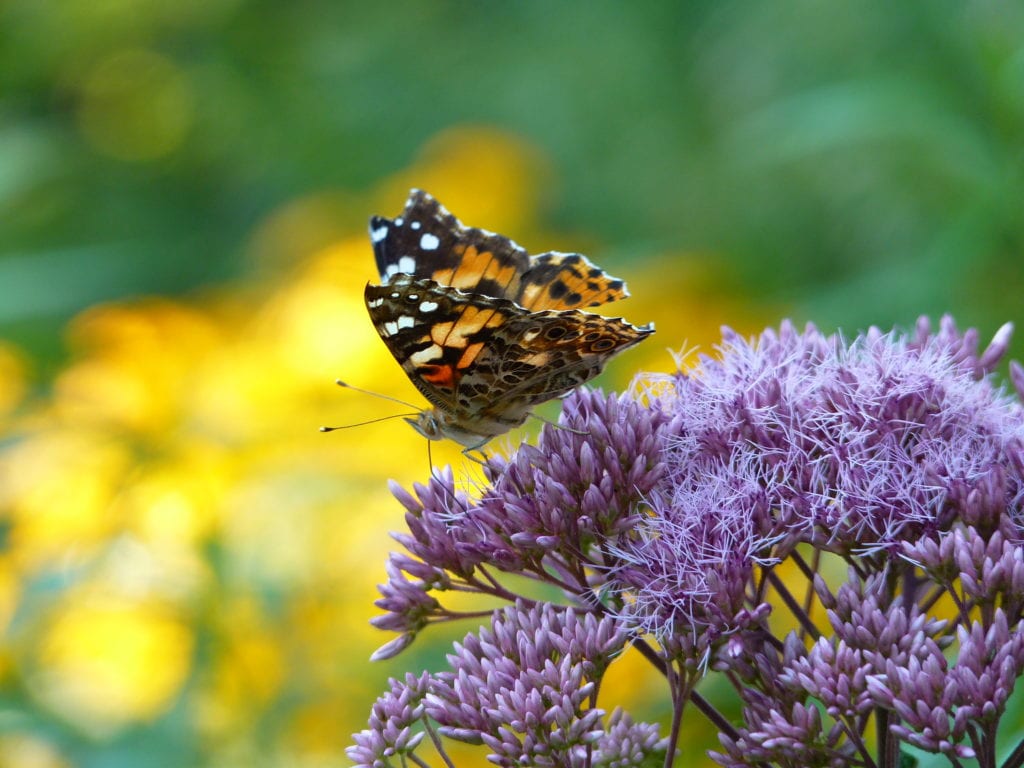by Neil Diboll
A number of flowers and grasses commonly associated with Midwestern prairies also occur in the meadows of New England. Some species are widely distributed throughout the region, while others are only occasional or rare. Most are more common in the prairie region, but some are abundant in the Northeast. Many make good garden plants, or as members of eastern meadows.
It is hypothesized that many plant species more commonly found in the central prairies expanded their ranges eastward during the mid-Holocene Warm Period (Xerothermic Period) approximately 8000 – 9000 years ago. Remnants of what were likely more extensive prairie-like meadows are typically found today on dry, rocky sites that are resistant to invasion by trees and other woody plants that would otherwise shade out the prairie flowers and grasses. Regularly mowed or hayed fields may also retain species more typical of western climes.
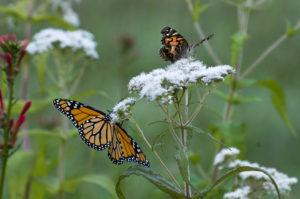
Eupatorium perfoliatum, Boneset with Monarch Butterfly. Photo by Allan Amioka
Some of the showiest flowers and grasses for gardens and meadows are listed below:
Wildflowers
| Scientific Name | Common Name | Notes |
| Asclepias incarnata | Marsh Milkweed | Favorite host plant for Monarch caterpillars; adapts to many soil types |
| Asclepias tuberosa | Butterflyweed | Requires well-drained soil with lots of sun |
| Aster laevis | Smooth Blue Aster | Highly adaptable; Late season pollinator nectar |
| Aster novae-angliae | New England Aster | Showy, adaptable, and great for pollinators |
| Ceanothus americanus | New Jersey Tea | Pollinated by small insects – Hummingbird food! |
| Chelone glabra | White Turtlehead | Host plant for Baltimore Checkerspot butterfly; requires rich, moist soil, in sun or part shade |
| Eryngium yuccifolium | Rattlesnake Master | Pollinated by parasitic and predacious wasps |
| Eutrochium maculatum | Joe Pye Weed | Outstanding butterfly nectar plant for wet soils |
| Eupatorium perfoliatum | Boneset | Attracts a wide range of pollinators; moist soils |
| Gentiana andrewsii | Bottle Gentian | Pollinated exclusively by bumblebees; moist soils |
| Hibiscus moscheutos | Rose Mallow | Large pink & white flower; Needs rich, moist soil |
| Lilium michiganense | Michigan Lily | Stunning orange flowers – hummingbird favorite. Requires rich, moist soil w/lots of organic matter |
| Lobelia cardinalis | Cardinal Flower | Bright red flowers light up pond edge & wet areas |
| Lupinus perennis | Wild Lupine | Light blue flowers in spring; Needs dry sandy soil |
| Monarda fistulosa | Bergamot | Attracts numerous butterflies; Use leaves for tea |
| Pycnanthemum tenuifolium | Narrowleaf Mtn. Mint | Attracts a wide variety of pollinators |
| Pycnanthemum virginianum | VA. Mtn. Mint | Pollinator magnet; Prefer moist soils |
| Rosa blanda | Meadow Rose | Highly adaptable; Upright form |
| Rosa carolina | Pasture Rose | Requires well-drained soil; spreads laterally |
| Rudbeckia laciniata | Greenhead Coneflower | Tall & showy wetland plant, sun or semi-shade |
| Senna hebecarpa | Wild Senna | Fantastic bee plant. Requires good soil |
| Sisyrinchium angustifolium | Narrowleaf Blue Eyed Grass | Very adaptable; Robin’s egg blue |
| Solidago speciosa | Showy Goldenrod | Classy conical flower; Pollinator magnet |
| Tephrosia virginiana | Goatsrue | Striking pink & yellow blooms. Needs dry sand |
| Tradescantia ohiensis | Ohio Spiderwort | Great spring bloomer; Goes dormant in summer |
| Veronicastrum virginicum | Culver’s Root | Elegant foliage and pure white flowers. Good soil |
| Viola pedata | Birdsfoot Violet | Striking flowers on a small plant; Require dry soil |
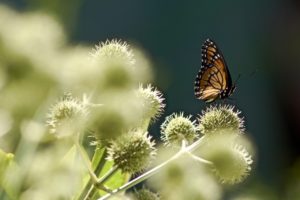
Monarch Butterfly on rattlesnake master (Eryngium yuccifolium) Photo by Nick Novick
Grasses
| Scientific Name | Common Name | Notes |
| Andropogon gerardii | Big Bluestem | Dominant prairie grass; Mix with tall flowers |
| Carex bicknellii | Bicknell’s Sedge | Great for mixing with low-growing flowers |
| Carex brevior | Plains Oval Sedge | Also good with shorter flowers |
| Carex vulpinoidea | Fox Sedge | Widely adaptable; Excellent rain garden plant |
| Elymus canadensis | Canada Wild Rye | Short-lived – Best in upland meadow seedings |
| Elymus virginicus | Virginia Wild Rye | Short-lived – Good for wetland meadow seedings |
| Eragrostis spectabilis | Purple Lovegrass | Pink seedheads in late summer; Requires dry soil |
| Panicum virgatum | Switchgrass | Architectural grass stands up all winter long |
| Schizachyrium scoparium | Little Bluestem | Showy crimson foliage in fall into winter |
| Sorghastrum nutans | Indiangrass | Golden fall color mixes well with Little Bluestem |
| Sporobolus heterolepis | Prairie Dropseed | Highly ornamental; Rare: SW CT & Central MA |
| Tridens flavus | Purpletop | Eastern meadow stalwart; Mix with taller flowers |
Please refer to this table listing all the species found in Midwestern Prairies and New England meadows for detailed information on each species listed above. Click here for more information.
The lower-growing sedges and shorter grasses such as Purple Lovegrass (1-2 ft.) Little Bluestem (2-3 ft.), and Prairie Dropseed (2-3 ft.) make good garden companions for most prairie flowers since they do not over-shadow them. The taller grasses, including Big Bluestem (5-8 ft.), Switchgrass (3-6 ft.), Indiangrass (5-7 ft.) and Purpletop (3-6 ft.) grow tall in mid to late summer, obscuring the fall-blooming flowers. Big Bluestem and Switchgrass also form a dense sod that can often squeeze out many of the flowers.
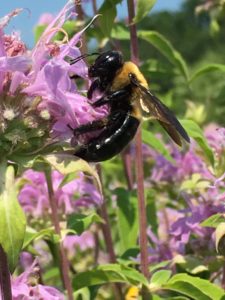
Beebalm (Monarda fistulosa) with a hungry bumble bee. Photo by Georgia Harris
Long-lived, deep-rooted flowers are best able to compete with the prairie grasses over the long-term. These include the following:
Butterflyweed – Prefers well-drained sandy soil, mixed with Lovegrass or Little Bluestem
New England Aster – Can compete with taller grasses
New Jersey Tea – Slow-growing but long-lived. Compatible with all grasses
Rattlesnake Master – Works well with short and tall grasses
Rose Mallow – Give this plant lots of room to spread out!
Lupine – Plant with Purple Lovegrass on dry sandy soil
Bergamot – Grows in almost any soil, with short and tall grasses
Meadow Rose – Looks best with short grasses but can compete with the big boys
Pasture Rose – Lower-growing does best with short grasses
Greenhead Coneflower – Wet soil only, Mix with Fox Sedge
Wild Senna – Needs a good, rich soil and can compete with tall grasses
Goatsrue – Plant with Purple Lovegrass and/or Little Bluestem in dry sand
Spiderwort – Long-lived and spreads by seed, in both short and tall grasses
Culver’s Root – Competes with tall grasses but looks best with sedges & short grasses
- New England Aster(Aster novae-angliae) with a butterfly. Photo by Lucy Birkett
- Joe Pye Weed (Eutrochium purpureum) with butterfly. Photo by Nanette Masi
Flowers that do not possess deep root systems can be mixed with lower-growing sedges and short prairie grasses. Fox Sedge is an excellent companion for other moisture-loving flowers such as those listed below:
- Marsh Milkweed
- Bottle Gentian
- Great St. Johnswort
- Michigan Lily
- White Turtlehead
- Cardinal Flower
- Joe Pye Weed
- Virginia Mountain Mint
- Boneset
- Golden Alexanders
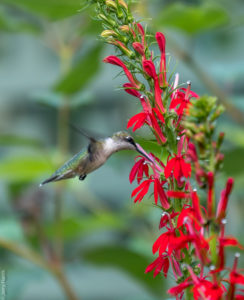
Hummingbird hovering over Cardinal Flower (Lobelia cardinalis). Photo by Jerry Harris
For dry sandy soils, the following wildflowers combination well with the drought tolerant grasses Purple Lovegrass, Little Bluestem, and Prairie Dropseed:
- Butterflyweed
- Narrow-leaved Mountain Mint
- Smooth Blue Aster
- Meadow Rose
- New Jersey Tea
- Pasture Rose
- Wild Lupine
All of the prairie grasses and sedges listed above grow well on medium (mesic) soils such as well-drained loam, sandy loam, and silt loam, with the exception of Fox Sedge (moist soil) and Purple Lovegrass (dry sandy soil). The two best short grasses for mixing with flowers on these soils are Little Bluestem and Prairie Dropseed. For maximum effect, especially with regard to fall color, these two grasses look best when planted in monocultures, mixed with flowers. The following prairie flowers make good companions when planted on mesic soils:
- Butterflyweed
- Smooth Blue Aster
- New England Aster
- New Jersey Tea
- Rattlesnake Master
- Narrowleaf Mountain Mint
- Culver’s Root
- Meadow Rose
- Wild Senna
- Narrow Leaved Blue Eyed Grass
- Showy Goldenrod
- Ohio Spiderwort
- Bergamot
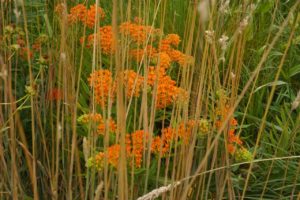
Butterflyweed (Asclepias tuberosa) in a meadow setting. Photo by Nick Novick.
These prairie flowers and grasses of the Midwestern Prairies can be combined with other New England natives to create attractive ecological gardens that support a wide variety of birds, butterflies, pollinators, and other creatures with whom we share our world.
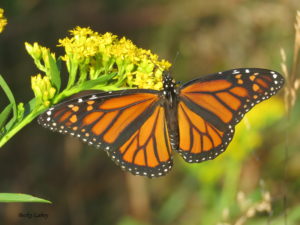
Monarch Butterfly on goldenrod (Solidago speciosa) Photo by Becky Laboy
Happy Native Gardening!
About the Author
Neil Diboll is a Prairie ecologist with a degree in Environmental Sciences from the University of Wisconsin – Green Bay who also attended the University of Michigan Biological Station in Pellston, MI (Boot Camp for Biologists). Neil has worked for the U.S. Park Service in Virginia, the U.S. Forest Service in Colorado, and for the University of Wisconsin.
The essence of Neil’s philosophy is that we, as stewards of the planet, must work to preserve and increase the diversity of native plants and animals, with which we share our world. The protection of our natural heritage and our soil and water resources is essential to maintaining a high quality of life for today, and for the children of future generations to come.

